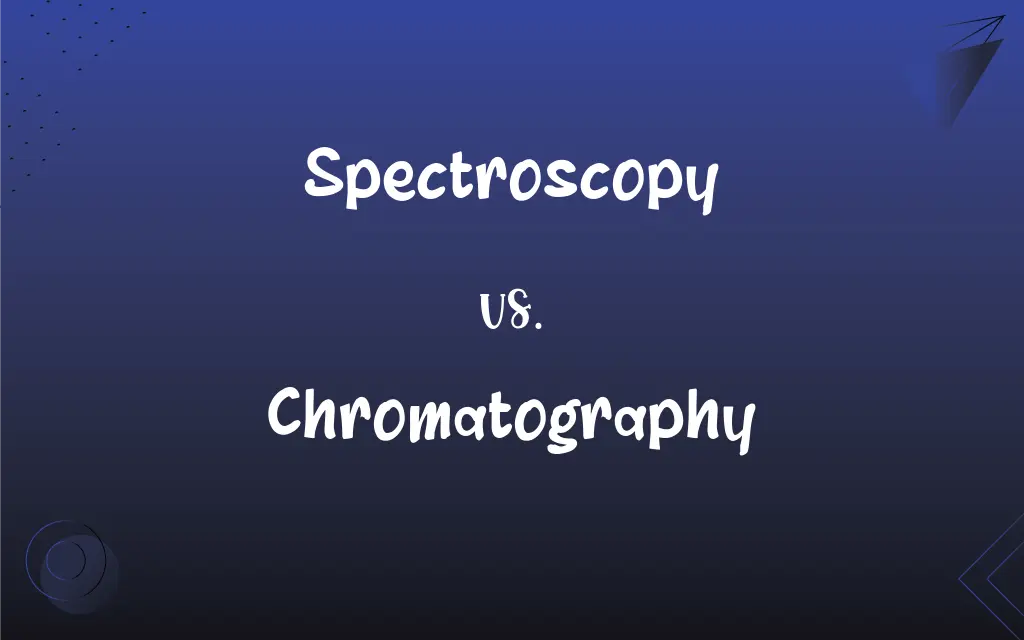Spectroscopy vs. Chromatography: What's the Difference?
Edited by Aimie Carlson || By Janet White || Updated on February 5, 2024
Spectroscopy is the study of the interaction between matter and electromagnetic radiation, while chromatography is a method for separating and analyzing mixtures of chemicals.

Key Differences
Spectroscopy and chromatography are two analytical techniques used extensively in chemistry, biology, and physics, but they serve different purposes and operate on distinct principles. Spectroscopy involves the measurement of the interaction between electromagnetic radiation and matter, providing insight into the molecular structure, composition, and physical properties of substances. Chromatography, conversely, separates the components of a mixture based on differences in their movement through a stationary medium under the influence of a mobile phase.
Spectroscopy identifies and quantifies substances through their spectral signatures - specific wavelengths of light absorbed, emitted, or scattered by molecules, while chromatography separates substances to allow for individual analysis. Spectroscopic techniques can determine the electronic, vibrational, and rotational states of molecules, offering qualitative and quantitative data about molecular structures and bonding. Chromatography, on the other hand, exploits the differential affinities of compounds to a stationary phase and a mobile phase to separate complex mixtures into their constituent parts.
The applications of spectroscopy and chromatography also differ widely. Spectroscopy is crucial in fields like astrophysics, materials science, and molecular biology for identifying chemical compounds and understanding physical conditions of celestial objects, materials, or biological samples. Chromatography is indispensable in pharmaceuticals, environmental analysis, and forensic science for purifying chemicals, analyzing pollutants, or detecting substances in complex biological matrices.
Spectroscopic methods include UV-Vis, infrared (IR), nuclear magnetic resonance (NMR), and X-ray spectroscopy, each tailored to specific types of analysis based on the energy levels of electrons, molecular vibrations, or nuclear environments. Chromatographic techniques, such as gas chromatography (GC), liquid chromatography (LC), and paper chromatography, vary by the phases used (solid or liquid stationary phases and gaseous or liquid mobile phases) and the physical properties they exploit (volatility, polarity, or size).
Spectroscopy provides detailed information on the nature and structure of chemical substances through their interactions with electromagnetic radiation, chromatography offers a powerful means to separate and purify components of mixtures, facilitating their subsequent identification and quantification by spectroscopy or other analytical methods.
ADVERTISEMENT
Comparison Chart
Principle
Interaction with electromagnetic radiation.
Separation based on differential affinities.
Purpose
Identifies and quantifies molecular characteristics.
Separates mixtures into individual components.
Applications
Molecular structure analysis, astrophysics.
Pharmaceutical analysis, environmental testing.
Techniques
UV-Vis, IR, NMR, X-ray spectroscopy.
Gas, liquid, paper chromatography.
Information Obtained
Molecular identity, concentration.
Component separation, purification.
ADVERTISEMENT
Analytical Focus
Molecular and atomic levels.
Mixture components.
Sample State
Solid, liquid, gas.
Primarily liquids and gases.
Operational Mode
Non-destructive analysis.
Can be either non-destructive or destructive.
Spectroscopy and Chromatography Definitions
Spectroscopy
Study of matter-radiation interaction.
Using infrared spectroscopy, we can identify organic compounds.
Chromatography
Process for analyzing and purifying chemical substances.
Liquid chromatography is essential for purifying proteins in research.
Spectroscopy
Technique for measuring radiation intensity.
X-ray spectroscopy is used to analyze the elemental composition of minerals.
Chromatography
Technique for separating mixture components.
Chromatography was used to isolate the different pigments in the leaf.
Spectroscopy
Analysis of light absorption and emission.
Spectroscopy revealed the chemical composition of the star.
Chromatography
Tool for identifying compounds in a mixture.
Using paper chromatography, students identified different ink components.
Spectroscopy
Tool for determining molecular structures.
Nuclear magnetic resonance spectroscopy provides detailed information about the molecular structure of proteins.
Chromatography
Application in separating biological molecules.
Affinity chromatography is used to isolate antibodies from serum.
Spectroscopy
Method for analyzing atomic and molecular energy levels.
Ultraviolet spectroscopy helps in studying the electronic transitions in molecules.
Chromatography
Method based on component affinity differences.
Gas chromatography effectively separated the volatile compounds in the sample.
Spectroscopy
The study of spectra, especially experimental observation of optical spectra or mass spectra, to determine the properties of their source.
Chromatography
Any of various techniques for the separation of complex mixtures that rely on the differential affinities of substances for a mobile (gas or liquid) medium and for a stationary adsorbing (liquid or solid) medium through which they pass, such as paper, gelatin, or silica.
Spectroscopy
A variety or instance of such study.
Chromatography
(analytical chemistry) Any of various techniques for the qualitative or quantitative separation of the components of mixtures of compounds; all characterised by the use of a mobile phase (gas or liquid) moving relative to a stationary phase (liquid or solid) – the differences between the rates of migration of the compounds between the two phases effects the separation.
Spectroscopy
(uncountable) The scientific study of spectra.
Chromatography
A treatise on colors
Spectroscopy
The use of spectrometers in chemical analysis.
Chromatography
An analytical and preparative technique for separating substances by differences in their selective adsorption to solids, by passing a liquid over the solid, to which the substances to be separated have usually been adsorbed in a preliminary step. The major variations are column chromatography, in which the substances to be separated are adsorbed to a column with any of a wide variety of adsorbing solids in powdered or granulated form; paper chromatography, in which the solids are applied as a spot at one end of a strip of absorbent paper (such as filter paper), and the liquid is percolated through the paper by capillary action; and thin-layer chromatography (TLC), which is similar to paper chromatography, but the adsorbent material is, instead of paper, a thin layer of finely powdered material, such as cellulose or silica, on a backing of glass or plastic, called a TLC plate. A modern version of column chromatography is high-performance liquid chromatography, usually referred to as HPLC.
Spectroscopy
The art and science dealing with the use of a spectroscope, and the production and analysis of spectra; the action of using a spectroscope.
Chromatography
A process used for separating mixtures by virtue of differences in absorbency
Spectroscopy
The use of spectroscopes to analyze spectra
FAQs
What is spectroscopy used for?
It's used to identify and quantify substances through their interaction with electromagnetic radiation.
What information can spectroscopy provide?
It can provide molecular identity, concentration, and structural information.
Is spectroscopy a chemical analysis method?
Yes, it's a chemical analysis method based on matter-radiation interaction.
Which is more suitable for separating proteins, spectroscopy or chromatography?
Chromatography, especially liquid chromatography, is more suitable for separating proteins.
How does the principle of chromatography differ from spectroscopy?
Chromatography is based on separation, while spectroscopy is based on detection and identification.
How does chromatography work?
It separates components of a mixture based on their differential affinities to stationary and mobile phases.
Can spectroscopy determine the structure of molecules?
Yes, techniques like NMR spectroscopy can determine molecular structures.
How are samples prepared for chromatography?
Sample preparation varies but often involves dissolving in a solvent compatible with the chromatography type.
Is spectroscopy capable of quantifying multiple substances simultaneously?
Yes, certain spectroscopic techniques can quantify multiple substances in a mixture.
What are the types of chromatography?
Includes gas, liquid, and paper chromatography, among others.
Can chromatography identify substances?
Chromatography primarily separates substances, but identification often requires subsequent analysis, like spectroscopy.
How do gas chromatography and liquid chromatography differ?
They differ in their mobile phase; gas chromatography uses a gas, while liquid chromatography uses a liquid.
17 Can chromatography be used in food safety analysis?
Yes, it's widely used to detect contaminants and additives in food products.
What role does spectroscopy play in environmental science?
Spectroscopy is used to detect and quantify pollutants in environmental samples.
What is the significance of mobile and stationary phases in chromatography?
They are crucial for the separation process, influencing the resolution and efficiency of separation.
What advancements have been made in spectroscopy for medical applications?
Techniques like Raman spectroscopy have advanced for non-invasive diagnostics.
Can spectroscopy analyze solid materials?
Yes, techniques like X-ray spectroscopy can analyze solid materials.
What makes spectroscopy important in astrophysics?
It allows the analysis of celestial bodies' composition and physical properties from afar.
Are there any limitations to using spectroscopy for material analysis?
Limitations include the need for specific equipment and sometimes extensive sample preparation.
How does temperature affect chromatographic separations?
Temperature can influence the volatility and solubility of compounds, affecting their separation.
About Author
Written by
Janet WhiteJanet White has been an esteemed writer and blogger for Difference Wiki. Holding a Master's degree in Science and Medical Journalism from the prestigious Boston University, she has consistently demonstrated her expertise and passion for her field. When she's not immersed in her work, Janet relishes her time exercising, delving into a good book, and cherishing moments with friends and family.
Edited by
Aimie CarlsonAimie Carlson, holding a master's degree in English literature, is a fervent English language enthusiast. She lends her writing talents to Difference Wiki, a prominent website that specializes in comparisons, offering readers insightful analyses that both captivate and inform.































































